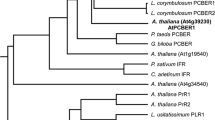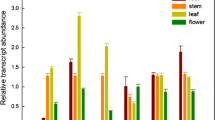Abstract
An Arabidopsis cDNA clone encoding 4-coumarate:CoA ligase (4CL), a key enzyme of phenylpropanoid metabolism, was identified and sequenced. The predicted amino acid sequence is similar to those of other cloned 4CL genes. Southern blot analysis indicated that 4CL is single-copy gene in Arabidopsis. Northern blots showed that 4CL expression was activated early during seedling development. The onset of 4CL expression was correlated with the onset of lignin deposition in cotyledons and roots 2–3 days after germination. The timing of the expression of a parsley 4CL1-GUS fusion in transgenic Arabidopsis seedlings was examined in parallel and was very similar to that of endogenous 4CL. In mature plants, highest 4CL expression was observed in bolting stems, where relatively large amounts of lignin accumulate. Both 4CL and 4CL1-GUS mRNA accumulation was strongly and transiently activated by wounding of mature Arabidopsis leaves. 4CL expression was specifically activated within 6 h after infiltration of Arabidopsis ecotype Columbia leaves with a Pseudomonas syringae pv. maculicola strain harboring the bacterial avirulence gene avrB, which causes in incompatible interaction. The timing of 4CL activation was identical to the previously observed activation of PAL gene expression in this interaction. No activation of 4CL expression was observed in a compatible interaction caused by a Pseudomonas syringae pv. maculicola strain without avrB.
Similar content being viewed by others
References
Allina SM, Douglas CJ: Isolation and characterization of the 4-coumarate:CoA ligase gene family in a poplar hybrid. Plant Physiol 105 (Suppl): 154 (1994).
Becker-André M, Schultze-Lefert P, Hahlbrock K: Structural comparison, modes of expression, and putative cis-acting elements of the two 4-coumarate:CoA ligase genes in potato. J Biol Chem 266: 8551–8559 (1991).
Bevan M, Schufflebottom D, Edwards K, Jefferson R, Schuch W: Tissue- and cell-specific activity of a phenylalanine ammonia-lyase promoter in transgenic plants. EMBO J 8: 1899–1906 (1989).
Bisgrove SR, Simonich MT, Smith NM, Sattler A, Innes RW: A disease resistance gene in Arabidopsis with specificity for two different pathogen avirulence genes. Plant Cell 6: 927–933 (1994).
daCosta e Silva O, Klein L, Schmelzer E, Trezzini GF, Hahlbrock K: BPF-1, a pathogen-induced DNA-binding protein involved in the plant defense response. Plant J 4: 125–135 (1993).
Debener T, Lehnackers H, Arnold M, Dangl JL: Identification and molecular mapping of a single Arabidopsis thaliana locos determining resistance to a phytopathogenic Pseudomonas syringae isolate. Plant J 1: 289–302 (1991).
Dharmawardhana DP, Ellis BE, Carlson JE: Characterization of vascular lignification in Arabidopsis thaliana. Can J Bot 70: 2238–2244 (1992).
Dong X, Mindrinos M, Davis K, Ausubel F: Induction of Arabidopsis defense genes by virulent and avirulent Pseudomonas syringae strains and by a cloned avirulence gene. Plant Cell 3: 61–72 (1991).
Douglas CJ, Hauffe KD, Ites-Morales ME, Ellard M, Paszkowski U, Hahlbrock K, Dangl JL. Exonic sequences are required for elicitor and light activation of a plant defense gene, but promoter sequences are sufficient for tissue specific expression. EMBO J 10: 1767–1775 (1991).
Doyle JJ, Doyle JL: Isolation of plant DNA from fresh tissue. Focus 12: 13–15 (1990).
Feinbaum RL, Ausubel FM: Transcriptional regulation of the Arabidopsis thaliana chalcone synthase gene. Mol Cell Biol 8: 1885–1892 (1988).
Fritzemeier K-H, Cretin C, Kombrink E, Rohwer F, Taylor J, Scheel D, Hahlbrock K: Transient induction of phenylalanine ammonia-lyase and 4-coumarate:CoA ligase mRNAs in potato leaves infected with virulent or avirulent races of Phytophthora infestans. Plant Physiol 85: 34–41 (1987).
Grand C, Boudet A, Boudet AM: Isoenzymes of hydroxycinnamate: CoA ligase prom poplar stems properties and tissue distribution. Planta 158: 225–229 (1983).
Hahlbrock K, Scheel D: Physiology and molecular biology of phenylpropanoid metabolism. Annu Rev Plant Physiol Plant Mol Biol 40: 347–469 (1989).
Hauffe KD, Paszkowski U, Schulzelefert P, Hahlbrock K, Dangl JL, Douglas CJ: A parsley 4CL-1 promoter fragment specifies complex expression patterns in transgenic tobacco. Plant Cell 3: 435–443 (1991).
Jefferson RA: Assaying chimeric genes in plants: the GUS gene fusion system. Plant Mol Biol Rep 5: 387–405 (1987).
Jorgensen A, Cuellar E, Thompson F: Modes and tempos in the evolution of nuclear encoded ribosomal RNA genes in legumes. Carnegie Inst of Washington Year Book 81: 98–101 (1982).
Joshi CP: An inspection of the domain between putative TATA box and translation start site in 79 plant genes. Nucl Acids Res 15: 6643–6653 (1987).
Keen NT, Buzzell R: New disease resistance genes in soybean against Pseudomonas syringae pv. glycinea: evidence that one of them interacts with a bacterial elicitor. Theor Appl Genet 81: 133–138 (1991).
Keen NT, Tamaki S, Kobayashi D, Trollinger DJ: Improved broad host range plasmids for DNA cloning in gram-negative bacteria. Gene 70: 191–197 (1988).
Kiedrowski S, Kawalleck P, Hahlbrock K, Somssich IE, Dangl JL: Rapid activation of a novel plant defense gene is strictly dependent on the Arabidopsis RPM1 disease resistance locus. EMBO J 11: 4677–4684 (1992).
Knobloch K-H, Hahlbrock K: Isoenzymes of p-coumarate: CoA ligase from suspension cultures of Glycine max. Eur J Biochem 52: 311–320 (1975).
Kozak M: Point mutations define a sequence flanking the AUG initiatior codon that modulates translation by eukaryotic ribosomes. Cell 44: 283–292 (1986).
Kubasek WL, Shirley BW, McKillop A, Goodman HM, Briggs W, Ausubel FM: Regulation of flavonoid biosynthesis genes in germinating Arabidopsis seedlings. Plant Cell 4: 1229–1236 (1992).
Lamb CJ, Lawton MA, Dron M, Dixon RA: Signals and tranduction mechanisms for activation of plant defenses against microbial attack. Cell 56: 215–224 (1989).
Liang X, Dron M, Schmid J, Dixon RA, Lamb CJ: Developmental and environmental regulation of a phenylalanine ammonia-lyase beta-glucuronidase gene fusion in transgenic tobacco plants. Proc Natl Acad Sci USA 86: 9284–9288 (1989).
Logemann J, Schell J, Willmitzer L: Improved method for the isolation of RNA from plant tissues. Anal Biochem 163: 16–20 (1987).
Lois R, Dietrich A, Hahlbrock K, Schulz W: A phenylalanine ammonia-lyase gene from parsley: structure, regulation and identification of elicitor and light responsive cis-acting elements. EMBO J 8: 1641–1648 (1989).
Lois R, Hahlbrock K: Differential wound activation of members of the phenylalanine ammonia-lyase and 4-coumarate:CoA ligase gene families in various organs of parsley plants. Z Naturforsch C 47: 90–94 (1992).
Lozoya E, Hoffmann H, Douglas CJ, Schulz W, Scheel D, Hahlbrock K: Primary structure and catalytic properties of isoenzymes encoded by the two 4-coumarate:CoA ligase genes in parsley. Eur J Biochem 176: 661–667 (1989).
Mindrinos M, Katagiri F, Yu G-L, Ausubel FM: The A. thaliana disease resistance gene RPS2 encodes a nucleotide-binding site and leucine-rich repeats. Cell 78: 1089–1099 (1994).
Moniz de Sá M, Subramaniam R, Williams FE, Douglas CJ: Rapid activation of phenylpropanoid metabolism in elicitor-treated hybrid poplar (Populus trichocarpa Torr and Gray × Populus deltoides Marsh) suspension-cultured cells. Plant Physiol 98: 728–737 (1992).
Murashige T, Skoog F: A revised medium for rapid growth and bioassays with tobacco tissue cultures. Physiol Plant 15: 473–497 (1962).
Ohl S, Hedrick SA, Chory J, Lamb CJ: Functional properties of a phenylalanine ammonia-lyase promoter from Arabidopsis. Plant Cell 2: 237–248 (1990).
Orr JD, Lynn DG: Biosynthesis of dehydrodiconiferyl alcohol glucosides: implications for the control of tobacco cell growth. Plant Physiol 98: 343–352 (1992).
Sambrook J, Fritsch EF, Maniatis T. Molecular Cloning: A Laboratory Manual. Cold Spring Harbor Press, Cold Spring Harbor, NY (1989).
Schmelzer E, Kruger-Lebus S, Hahlbrock K: Temporal and spatial patterns of gene expression around sites of attempted fungal infection in parsley leaves. Plant Cell 1: 993–1001 (1989).
Schmid J, Doerner PW, Clouse SD, Dixon RA, Lamb CJ: Developmental and environmental regulation of a bean chalcone synthase promoter in transgenic tobacco. Plant Cell 2: 619–631 (1990).
Sharma YK, Davbis KR: Ozone-induced expression of stress-related genes in Arabidopsis thaliana. Plant Physiol 105: 1089–1096 (1994).
Subramaniam R, Reinold S, Molitor EK, Douglas CJ: Structure, inheritance, and expression of hybrid poplar (Populus trichocarpa × Populus deltoides) phenylalanine ammonia-lyase genes. Plant Physiol 102: 71–83 (1993).
Trezzini GF, Horrichs A, Somssich IE: Isolation of putative defense-related genes from Arabidopsis thaliana and expression in fungal elicitor-treated cells. Plant Mol Biol 21: 385–389 (1993).
Uhlmann A, Ebel J: Molecular cloning and expression of 4-coumarate:coenzyme A ligase, an enzyme involved in the resistance of soybean (Glycine max L.) against pathogen infection. Plant Physiol 102: 1147–1156 (1993).
Valvekens D, VanMontagu M, VanLijsebettens M: Agrobacterium tumefaciens-mediated transformation of Arabidopsis thaliana root explants by using kanamycin selection. Proc Natl Acad Sci USA 85: 5536–5540 (1988).
Wanner LA, Mittal S, Davis KR: Recognition of the avirulence gene avrB from Pseudomonas syringae pv. glycinea by Arabidopsis thaliana. Mol Plant-Microbe Interact 6: 582–591 (1993).
Wanner LE, Li G, Ware DH, Somssich I, Davis KR: The phenylalanine ammonia-lyase gene family in Arabidopsis thaliana. Plant Mol Biol 27: 327–338 (1995).
Wu SC, Hahlbrock K: In situ localization of phenylpropanoid-related gene expression in different tissues of light-grown and dark-grown parsley seedlings. Z Naturforsch C 47: 591–600 (1992).
Zhao Y, Kung SD, Dube SK: Nucleotide sequence of rice 4-coumarate:CoA ligase gene, 4-CL.1. Nucl Acids Res 18: 6144 (1990).
Author information
Authors and Affiliations
Rights and permissions
About this article
Cite this article
Lee, D., Ellard, M., Wanner, L.A. et al. The Arabidopsis thaliana 4-coumarate:CoA ligase (4CL) gene: stress and developmentally regulated expression and nucleotide sequence of its cDNA. Plant Mol Biol 28, 871–884 (1995). https://doi.org/10.1007/BF00042072
Received:
Accepted:
Issue Date:
DOI: https://doi.org/10.1007/BF00042072




